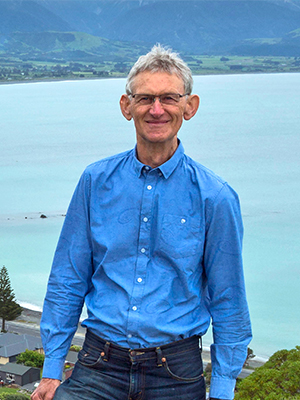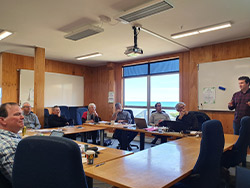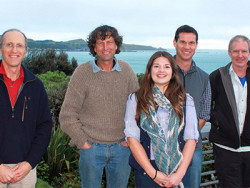Hurunui Waiau Uwha Water Zone progress report
Each of Waitaha/Canterbury’s water zone committees has an action plan which outlines how they will work with the community to deliver their aspirations for freshwater as outlined in the Canterbury Water Management Strategy (CWMS). Committees report annually to let the CWMS partners and community know how things are tracking.
2021/22 progress report
From the chair: Kaitiakitanga heart of environment awareness

Ted Howard, Kaikōura Water Zone Committee Chair.
Our committee is made up of a group of people who are passionate about water and the many levels of life it sustains. Our members have lots of different backgrounds, experiences, and expertise to draw from.
This year, COVID-19 Level 4 restrictions presented some challenges that meant we quickly became familiar with online meetings – something that helped us stay connected, even if it was through a screen.
We were pleased to be able to recommend several biodiversity projects for Immediate Steps funding, which shows how dedicated our landowners are to enhancing and protecting the local environment.
More generally, over the past five years as Chair, it has been great to see many environmental projects delivered and so many people engaged.
Challenges have arisen over the years, most memorably the damage caused by the earthquakes, but this just highlights the complexities of nature.
These complex natural systems are constantly changing and working with them requires a willingness to constantly observe and adapt.
This is the heart of environmental awareness and responsibility; it is part of kaitiakitanga/guardianship of our natural world.
It is inspiring to see so many people who care about our beautiful taiao and are willing to take action to protect it for future generations.
We hope to be able to continue supporting these actions and initiatives – it is a journey, always, and we look forward to the next year of this journey with you.
Ted Howard.
Delivering the community's vision for freshwater
The Canterbury Water Management Strategy (CWMS) puts finding solutions for freshwater management in the hands of the community, with support from councils, Ngāi Tahu, and others. The strategy sets out freshwater goals and targets to deliver the community’s vision for freshwater.
Each of the community-led water zone committees work collaboratively to develop freshwater recommendations to ensure council plans give effect to these goals and targets.
Within each target area, there are several specific time-bound targets to be achieved and these are monitored and reported on to ensure progress is being made.
The CWMS targets are: Environmental limits, Ecosystem health and biodiversity, Natural character of braided rivers, Kaitiakitanga, Drinking water, Recreational and amenity opportunities, Water use efficiency, Irrigated land area, Energy security and efficiency and Indicators of regional and national economies.
Local projects helping to deliver on the CWMS targets
Read some of the stories about what is being done in the zone to achieve deliver on the CWMS targets.
Ecology and environmental impact at forefront of Kaikōura coastal work
The transport corridor remains one of the zone committee’s top priorities in the Kaikōura Zone Implementation Plan (ZIP).
The committee was thrilled to have been kept up to date by North Canterbury Transport Infrastructure Recovery alliance (NCTIR) as work progressed.
NCTIR has undertaken works on nearly every bridge and culvert crossing along the coast, with careful planning to reduce the effects on native fish.
More than 5,500 fish have been salvaged during stream works and NCTIR has reinstated fish passages in places where infrastructure had eroded and blocked off fish access to upper waterways.
All fish caught during NCTIR’s work has been reported to the New Zealand freshwater fish database, providing information to a national ‘big-picture’ for fish species – something the committee is pleased that anyone, anywhere can access.
This work helps meet these CWMS targets: Environmental limits, Ecosystem health and biodiversity and Natural character of braided rivers

NCTIR’s Project Ecologist Gareth Taylor presents to the KWZC on work to mitigate impacts on local flora and fauna.
Regenerative farming kōrero in Kaikōura
Water Zone Committee member Tony Blunt was one of the key speakers at Kaikōura’s first regenerative farming event, which drew interest from farmers, vintners, and industry professionals across the South Island.
The event was hosted by local regenerative farming awareness platform Agregenz and sponsored by the North Canterbury Rural Support Trust and the Organic Dairy and Pastoral Group. Kaikōura Plains Recovery Project also supported the event.
Tony was pleased that new and innovative ideas are weaving their way into farming practice, helping to improve on-farm land and water management, a priority outcome for the committee.
With regenerative farming a bit of a hot topic at the moment, Tony hoped that the event provided everyone with context and experience to help them understand what regenerative farming is all about.
This work helps meet these CWMS targets: Environmental limits, Ecosystem health and biodiversity and Natural character of braided rivers

John King, Tony Blunt, Sky Horton (event organiser), Hamish Bielski and James Costello.
Wetland mapping on Mt Fyffe Farm reveals rare species
Mt Fyffe Farm wetland was mapped earlier in 2020, with important plant species found such as harakeke, purei (sedges), and swamp asteilia, which is uncommon on New Zealand's East Coast.
With the protection of biodiversity and improvement of streams and wetlands as priority outcomes in the Kaikōura Zone Implementation Plan (ZIP) (PDF file, 4.71MB), the committee recommended this project for up to $18,000 of IMS funding.
Around 1.9 hectares of wetland will be fenced and protected on the sheep and beef farm, with additional planting and seeding, and weed and predator control.
The protection of the mānuka-dominant wetland is a step towards fulfilling obligations to protect endemic biodiversity and local identity, as the unique environment shapes the community.
The zone committee unanimously supported the project and believes that it helps meet targets for biodiversity and habitat creation, as set out in the Canterbury Water Management Strategy (CWMS).
This work helps meet these CWMS targets: Environmental limits, Ecosystem health and biodiversity and Natural character of braided rivers

Our ecologist Helen Greenep at Mt Fyffe Farm wetland.
Committee's key achievements
- The Waiau Toa/Clarence Weed Control Project received a $250,000 funding boost from Land Information New Zealand (LINZ). The project initially received IMS funding to protect indigenous biodiversity through ongoing weed and pest control in the catchment.
- North Canterbury Transport Infrastructure Recovery (NCTIR) kept the committee up-to-date on their environmental and ecological work to mitigate impacts on local flora and fauna during the earthquake recovery programme. The transport corridor is a committee priority.
- Mill Road wetland, Greenburn wetland, Kōmanawa o te Waikōau and Poipoi Kotare Stream were all recommended for IMS funding. These projects contribute to increased biodiversity values and water quality across the district.
- Committee member Tony Blunt was one of the key speakers at Kaikōura’s first regenerative farming event.
